The document discusses acute pulmonary emergencies in pediatrics, focusing on pulmonary embolism (PE) and pulmonary edema, including their pathophysiology, diagnostic approaches, and management strategies. It presents a specific case of a 13-year-old girl with prior deep venous thrombus who presents with sudden onset chest pain and shortness of breath, underscoring the importance of assessment in pediatric populations. Additionally, it highlights risk factors, clinical features, and treatment options for pediatric patients experiencing these conditions.
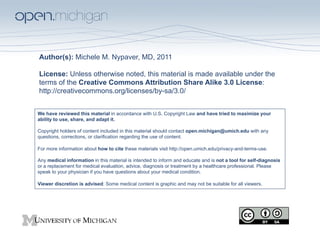



















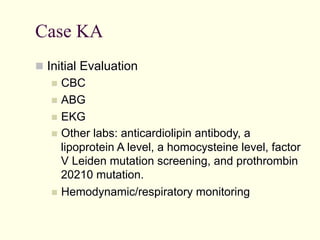
![Evaluation of Children with Suspected
PE
Toolbox
ABG: Low paO2; low
paCO2 initially, ominous
rise in paCO2
EKG: Sinus tachycardia,
RAD, RVH, RBBB
Increased a-A gradient
D-Dimer: Highly sensitive
in adults coupled with
clinical evaluation to r/o
PE; Few data in children
and false positive in
Source Unknown
presence of infection/
A-a gradient = PAO2 − PaO2
malignancy.
Aa Gradient = [FiO2*(Patm-PH2O)-(PaCO2/0.8) ] PaO2
Aa Gradient = (150 - 5/4(PCO2)) - PaO2](https://image.slidesharecdn.com/medicine-ghanaemcollaborativeem-acutepulmonaryemergencies-lecture-nypaver0-140217125621-phpapp01/85/GEMC-Acute-Pulmonary-Emergencies-Pulmonary-Embolism-Pulmonary-Edema-and-Parapneumonic-Effusions-Resident-Training-22-320.jpg)
























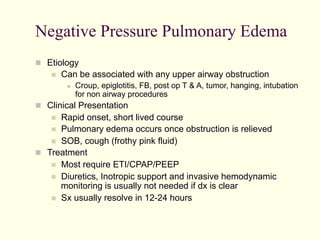


















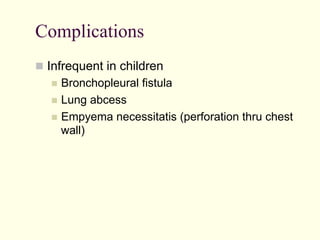

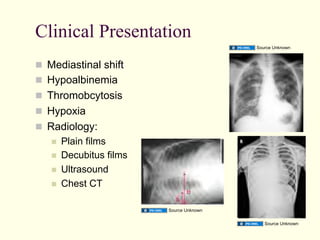




![Who Gets a Chest Tube?
Large amounts of free flowing pleural fluid
Evidence of fibrinopurulent effusions (eg, pH
<7.0, glucose <40 mg/dL [2.22 mmol/L], LDH
>1000 IU [16.67 kat/L], positive gram stain,
frank pus)
Failure to respond to 48 to 72 hours of
antibiotic therapy
Compromised pulmonary function (eg, severe
hypoxemia, hypercapnia )](https://image.slidesharecdn.com/medicine-ghanaemcollaborativeem-acutepulmonaryemergencies-lecture-nypaver0-140217125621-phpapp01/85/GEMC-Acute-Pulmonary-Emergencies-Pulmonary-Embolism-Pulmonary-Edema-and-Parapneumonic-Effusions-Resident-Training-73-320.jpg)


![Additional Source Information
for more information see: http://open.umich.edu/wiki/CitationPolicy
Slide 7, Image 1: Persian Poet Gal, "Blood Clot Diagram (Thrombus)", Wikimedia Commons, http://commons.wikimedia.org/wiki/
File:Blood_clot_diagram.png, CC: BY-SA 3.0, http://creativecommons.org/licenses/by-sa/3.0/deed.en.
Slide 7, Image 2: Please see original image of DVT/Pulmonary Embolism at http://www.activeforever.com/t-deep-vein-thrombosis-article.aspx
Slide 8, Image 1: Please see original image of Pulmonary Embolism at http://www.riversideonline.com/source/images/image_popup/
r7_pulmonaryembolism.jpg
Slide 9, Image 1: Please see original image of Pulmonary Embolism at http://www.ncbi.nlm.nih.gov/pubmedhealth/PMH0001189/
Slide 9, Image 2: Source Unknown
Slide 14, Table 1: Wells PS et al. Ann Intern Med. 1998;129;997.
Slide 22, Image 1: Source Unknown
Slide 25, Image 1: Source Unknown
Slide 25, Image 2: Source Unknown
Slide 26, Image 1: Source Unknown
Slide 26, Image 2: Source Unknown
Slide 27, Image 1: Source Unknown
Slide 29, Image 1: Source Unknown
Slide 30, Image 1: Source Unknown
Slide 31, Image 1: Source Unknown
Slide 32, Image 1: Source Unknown
Slide 33, Image 1: Source Unknown
Slide 34, Image 1: Source Unknown
Slide 34, Image 2: Source Unknown
Slide 36, Image 1: Source Unknown
Slide 38, Image 1: Anatomical drawing of Pulmonary Edema removed.
Slide 38, Image 2: Source Unknown
Slide 39, Image 0: Please see original image of [brief description] at [URL of original, if available]](https://image.slidesharecdn.com/medicine-ghanaemcollaborativeem-acutepulmonaryemergencies-lecture-nypaver0-140217125621-phpapp01/85/GEMC-Acute-Pulmonary-Emergencies-Pulmonary-Embolism-Pulmonary-Edema-and-Parapneumonic-Effusions-Resident-Training-76-320.jpg)
